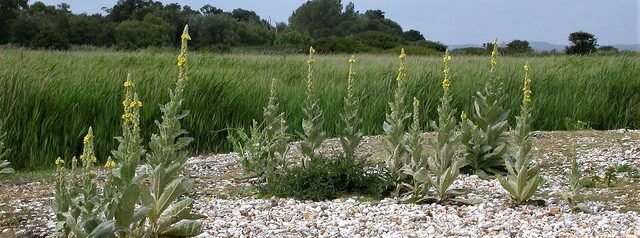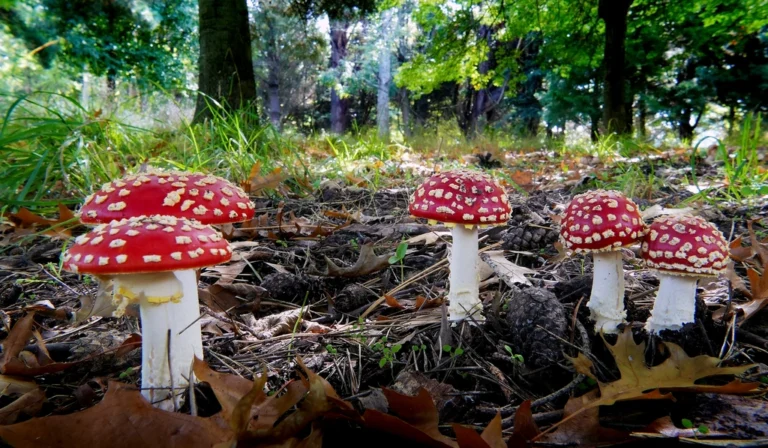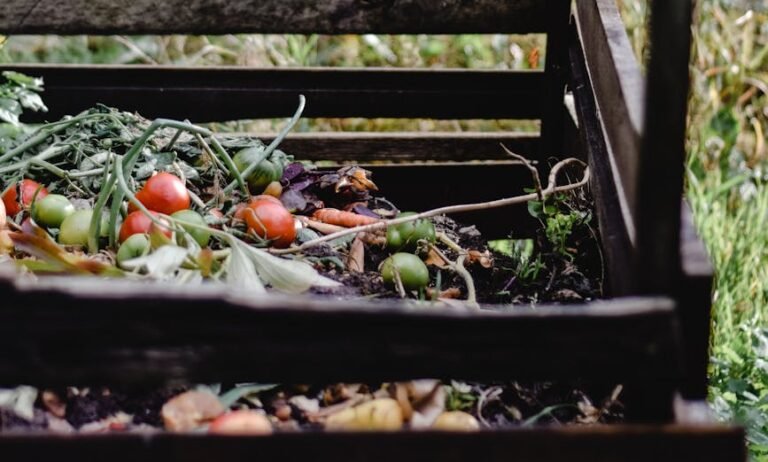Nature’s Forgotten Medicine Cabinet
Imagine this: You’re walking through your neighborhood, when you see a tall, fuzzy plant growing wild in abandoned lots, along roadsides, maybe even in your own backyard. Most people see it as an ugly weed, something to be pulled up and thrown away.
But what if I told you that this humble plant has been revered by healers for over 2,000 years? What if I said Native Americans called it “the great healer,” and European monks cultivated it in their monastery gardens as sacred medicine?
This plant – Mullein – is quite literally nature’s pharmacy hiding in plain sight. While you’ve been spending hundreds of dollars on cough medicines, throat lozenges, and respiratory treatments, this fuzzy “weed” has been quietly offering the same benefits, completely free.
Today, I’m going to show you exactly how to identify, harvest, and use this incredible plant. By the end of this article, you’ll never look at your yard the same way again.

THE MULLEIN REVELATION
Why This Matters Now More Than Ever
In our modern world, we’re facing a health crisis. Respiratory issues are skyrocketing. Pharmaceutical costs are crushing families. People are desperately seeking natural alternatives that work.
Meanwhile, Mullein has been solving these exact problems for millennia. This isn’t some new-age fad or unproven remedy. This is ancient wisdom backed by modern science, and it’s been growing right under our noses.
The Hidden History
Mullein’s story reads like a medical thriller. Ancient Greeks used it to treat lung diseases. Roman soldiers carried it on long marches to prevent respiratory infections. Native American tribes across the continent independently discovered its healing powers, calling it “the plant that heals from within.”
During the 1918 flu pandemic, when hospitals were overwhelmed and medicine was scarce, rural communities turned to Mullein. They brewed teas, made poultices, and even smoked the leaves. Their survival rates were notably higher than urban areas.
But here’s what’s truly remarkable: Mullein doesn’t just treat symptoms. It addresses root causes. It doesn’t just suppress coughs; it heals the lungs. It doesn’t just reduce inflammation; it strengthens the entire respiratory system.
The Modern Rediscovery
Recent studies have validated what traditional healers always knew. Mullein contains powerful compounds called saponins, mucilage, and flavonoids. These work synergistically to:
- Reduce inflammation in respiratory tissues
- Break down mucus naturally
- Strengthen lung capacity
- Support immune function
- Heal damaged airways
The pharmaceutical industry has been trying to synthesize these compounds for decades. But nature already perfected the formula. And it’s growing wild, completely free.

IDENTIFICATION
Spotting Mullein: Your Visual Guide
Mullein identification is actually easier than you think. Once you know what to look for, you’ll start seeing it everywhere.
First Year Plants (Rosette Stage):
- Large, fuzzy leaves arranged in a circular pattern close to the ground
- Leaves feel like velvet – soft and woolly
- Pale green to gray-green color
- Leaves can grow 12-18 inches long
- Grows in disturbed soil, sunny locations
Second Year Plants (Flowering Stage):
- Tall flower spike, 3-10 feet high
- Bright yellow flowers clustered densely on the spike
- Same fuzzy, velvet-like leaves
- Flowers bloom from bottom to top throughout summer
- Unmistakable candle-like appearance
Key Identifying Features:
- The “toilet paper test” – leaves are so soft they were actually used as natural toilet paper
- Fuzzy stem and leaves (this fuzziness protects the plant and concentrates its medicinal compounds)
- Grows in poor, rocky, or disturbed soil where other plants struggle
- Found in sunny, open areas
Common Look-Alikes to Avoid:
- Lamb’s ear (similar fuzziness but different leaf shape)
- Foxglove (similar flower spike but toxic – flowers are bell-shaped)
Pro Identification Tips:
- Mullein leaves have a distinctive “woolly” texture that’s unmistakable
- The flower spike grows straight up like a natural candle
- Look for the rosette pattern in first-year plants
- Check for the characteristic yellow, five-petaled flowers

THE 9 POWERFUL BENEFITS
The Complete Mullein Medicine Cabinet
1. Earache Relief Mullein oil is nature’s answer to ear infections. The anti-inflammatory compounds penetrate deep into ear tissues, reducing pain and fighting infection naturally.
2. Skin Healing The mucilage in Mullein creates a protective barrier over wounds, speeding healing and preventing infection. It’s particularly effective for burns, cuts, and eczema.
3. Digestive Support Mullein’s soothing compounds calm irritated digestive tissues, making it valuable for stomach inflammation and digestive discomfort.
4. Joint Pain Relief The anti-inflammatory properties extend to joint health, making Mullein useful for arthritis and general joint pain.
5. Sleep Enhancement Mullein’s gentle sedative properties promote restful sleep without the grogginess of pharmaceutical sleep aids.
6. Immune System Boost Regular Mullein use strengthens overall immune function, helping your body fight off infections before they take hold.
THE BIG THREE: Mullein’s Signature Healing Powers
7. RESPIRATORY MASTERY – The Lung Healer
This is where Mullein truly shines. For over 2,000 years, healers have turned to Mullein for one primary reason: it’s the most effective natural lung medicine on Earth.
Here’s what makes it so powerful:
Mucilage Magic: Mullein contains special compounds called mucilages that become gel-like when mixed with water. When you drink Mullein tea, these mucilages coat your entire respiratory tract, from throat to lungs. This coating:
- Soothes irritated tissues
- Reduces coughing fits
- Helps expel stuck mucus
- Protects against further irritation
Saponin Power: These natural compounds work like nature’s own expectorant, breaking down thick mucus and making it easier to cough up productively.
Anti-inflammatory Action: Mullein reduces swelling in airways, making breathing easier and more comfortable.
Real-world applications:
- Chronic cough that won’t quit
- Bronchitis and chest congestion
- Asthma support (not a replacement for emergency inhalers)
- Smoker’s cough
- Seasonal respiratory issues
- Recovery from respiratory infections
8. ANTI-INFLAMMATORY POWERHOUSE – The Natural Steroid
Chronic inflammation is the root of most modern diseases. Mullein contains powerful anti-inflammatory compounds that work systemically throughout your body.
Unlike pharmaceutical anti-inflammatories that come with serious side effects, Mullein’s anti-inflammatory action is gentle yet effective. It works by:
Blocking Inflammatory Pathways: Mullein compounds interfere with the body’s inflammatory cascade, stopping inflammation at its source.
Cellular Protection: The antioxidants in Mullein protect cells from inflammatory damage.
Tissue Repair: Mullein actually helps repair tissue damage caused by chronic inflammation.
Applications:
- Arthritis and joint pain
- Inflammatory bowel conditions
- Skin inflammation
- Respiratory inflammation
- General chronic inflammation
9. ANTIMICROBIAL SHIELD – The Natural Antibiotic
In an era of antibiotic-resistant bacteria, Mullein offers a powerful natural alternative. Research shows Mullein is effective against:
Bacterial Infections: Including Staphylococcus aureus, E. coli, and Pseudomonas aeruginosa
Viral Infections: Particularly respiratory viruses
Fungal Infections: Including Candida species
The Mullein Advantage:
- Bacteria don’t develop resistance to Mullein
- No disruption of beneficial gut bacteria
- Strengthens rather than weakens immune system
- Can be used long-term safely

HARVESTING
When, Where, and How to Harvest Like a Pro
Timing Is Everything:
Best Harvesting Times:
- Leaves: Early morning after dew has dried, before the heat of the day
- Flowers: Mid-morning when flowers are fully open
- Roots: Late fall or early spring when plant energy is concentrated in roots
Seasonal Harvest Calendar:
- Spring: New rosette leaves (most tender)
- Summer: Flowers and mature leaves
- Fall: Seeds and roots
- Winter: Dried material for storage
Harvesting Techniques:
For Leaves:
- Choose healthy, unblemished leaves
- Harvest outer leaves first, leaving center to continue growing
- Cut with clean scissors or knife
- Never harvest more than 1/3 of the plant at once
For Flowers:
- Pick flowers in small batches as they open
- Flowers are ready when bright yellow and fully opened
- Gently twist off flower clusters
- Harvest daily during blooming season
For Roots:
- Dig carefully with a spade or digging fork
- Choose mature, second-year plants
- Clean roots thoroughly
- Harvest in fall for maximum potency
Sustainable Harvesting Ethics:
- Always leave enough plant material for regeneration
- Never harvest the last plant in an area
- Rotate harvesting locations
- Thank the plant (traditional practice that maintains mindful harvesting)
Quality Indicators:
- Leaves should be fuzzy and silver-green
- Flowers should be bright yellow and fresh
- Avoid plants near roads or polluted areas
- Choose plants from clean, pesticide-free locations

PREPARATION METHODS
From Plant to Powerful Medicine
Immediate Use Preparations:
Fresh Mullein Tea (The Daily Dose):
- Use 1/4 cup fresh leaves per cup of water
- Pour boiling water over leaves
- Steep 10-15 minutes
- Strain through fine mesh (removes fuzzy particles)
- Add honey for taste and additional benefits
Fresh Flower Oil (Ear Infection Fighter):
- Fill small jar with fresh flowers
- Cover completely with olive oil
- Let sit in sunny window for 2 weeks
- Strain and store in dark glass bottle
- Use 2-3 drops in affected ear
Food Preparations:
Mullein Leaf Wraps:
- Young, tender leaves work best
- Blanch briefly in boiling water
- Use as wraps for rice, vegetables, or meat
- Adds mild, pleasant flavor
- Rich in minerals and vitamins
Mullein Flower Fritters:
- Dip flower clusters in light batter
- Fry quickly in oil
- Crispy texture with mild, sweet flavor
- Traditional European preparation
Medicinal Preparations:
Concentrated Mullein Tincture:
- Chop fresh leaves and flowers
- Pack in glass jar
- Cover with 80-proof vodka
- Shake daily for 2-4 weeks
- Strain and store in dark bottles
- Use 1-2 droppers full as needed
Mullein Syrup (Cough Medicine):
- Simmer 1 cup fresh leaves in 2 cups water for 20 minutes
- Strain liquid
- Add equal amount of honey
- Simmer until thick
- Store in refrigerator
- Take 1 tablespoon for cough relief
Dried Mullein Storage:
- Hang leaves in small bundles
- Dry in warm, airy location
- Store in airtight containers
- Label with harvest date
- Keeps potency for 1-2 years
Advanced Preparations:
Mullein Smoking Blend:
- Dry leaves completely
- Crumble into fine pieces
- Mix with other herbs if desired
- Traditional use for lung cleansing
- Use sparingly and mindfully
Mullein Poultice:
- Crush fresh leaves to release juices
- Apply directly to skin irritation
- Cover with clean cloth
- Replace every 2-4 hours
- Excellent for wounds and inflammation

THREE SIGNATURE RECIPES
Master Recipes for Maximum Impact
Recipe 1: The Lung Liberator Tea Blend
Ingredients:
- 3 parts dried Mullein leaves
- 1 part dried Mullein flowers
- 1 part dried elderflower
- 1/2 part dried thyme
- Honey to taste
Preparation:
- Mix all dried herbs in airtight container
- Use 1 tablespoon per cup of boiling water
- Steep covered for 15 minutes
- Strain through fine mesh
- Add honey while warm
- Drink 2-3 cups daily during respiratory issues
Why It Works: This blend combines Mullein’s lung-healing properties with elderflower’s immune support and thyme’s antimicrobial action. The result is a powerful respiratory tonic that tastes great and works fast.
Recipe 2: Golden Healing Oil
Ingredients:
- 1 cup fresh Mullein flowers
- 1 cup high-quality olive oil
- 1 tablespoon calendula flowers (optional)
- Dark glass bottles for storage
Preparation:
- Fill glass jar with fresh flowers
- Cover completely with oil
- Place in sunny window for 2 weeks
- Strain through cheesecloth
- Store in dark glass bottles
- Label with date
Uses:
- Ear infections (2-3 drops)
- Skin irritation and wounds
- Muscle and joint pain
- Dry skin conditions
Recipe 3: Mullein Fire Cider
Ingredients:
- 1/4 cup fresh Mullein leaves
- 1/4 cup fresh ginger root
- 1/4 cup fresh horseradish root
- 1 onion, chopped
- 4 cloves garlic
- 2 cups apple cider vinegar
- Honey to taste
Preparation:
- Chop all fresh ingredients
- Pack in glass jar
- Cover with vinegar
- Shake daily for 4 weeks
- Strain and add honey
- Take 1 tablespoon at first sign of illness
This recipe combines Mullein’s respiratory benefits with immune-boosting ingredients for a powerful preventive medicine.

SAFETY AND ADVANCED TIPS
Using Mullein Safely and Effectively
Safety Considerations:
Generally Safe For:
- Adults in normal doses
- Children over 12 (with reduced dosing)
- Long-term use
- Pregnant women (in moderation)
Precautions:
- Always strain teas to remove fuzzy particles
- Start with small amounts to test tolerance
- Avoid if allergic to plants in the figwort family
- Consult healthcare provider for serious conditions
Drug Interactions:
- May enhance effects of sedatives
- Could interact with blood thinners
- Consult doctor if taking prescription medications
Maximizing Effectiveness:
Dosage Guidelines:
- Tea: 1-3 cups daily
- Tincture: 1-2 droppers full, 2-3 times daily
- Oil: 2-3 drops for ears, apply topically as needed
Combining with Other Remedies:
- Excellent with elderberry for immune support
- Pairs well with ginger for respiratory issues
- Complements echinacea for infection fighting
Storage and Potency:
- Store dried herbs in airtight containers
- Keep oils in dark glass bottles
- Label everything with dates
- Replace dried herbs annually

YOUR MULLEIN JOURNEY BEGINS
You now possess knowledge that was once the exclusive domain of traditional healers and herbalists. You understand how to identify, harvest, and use one of nature’s most powerful medicines.
This isn’t just about saving money on cough medicine or avoiding pharmaceutical side effects. This is about reconnecting with ancient wisdom, taking control of your health, and discovering the incredible healing power that’s been hiding in plain sight.
The next time you see that fuzzy, tall plant growing wild in your neighborhood, you’ll know exactly what you’re looking at. You’ll see nature’s pharmacy, not a weed. You’ll see thousands of years of healing tradition, not something to be ignored.
Your journey with Mullein starts now. Start small – identify a plant, harvest a few leaves, make your first tea. Pay attention to how your body responds. Notice the difference in your respiratory health, your energy levels, your overall well-being.
Share this knowledge. Teach your friends and family. Help them see the medicine growing wild around them.
The plant that everyone ignores is waiting to become your most trusted healing ally. The question is: are you ready to listen?
Support Our Writing Journey
Your support keeps our words alive and our stories flowing. Every donation, no matter the size, helps us continue creating meaningful content, sharing important narratives, and maintaining our creative mission. By contributing, you’re not just supporting a writer; you’re investing in storytelling, creativity, and the power of words. Help us sustain our independent writing, fuel future projects, and keep our content accessible. Your generosity directly supports working writers and helps us continue our artistic work.





